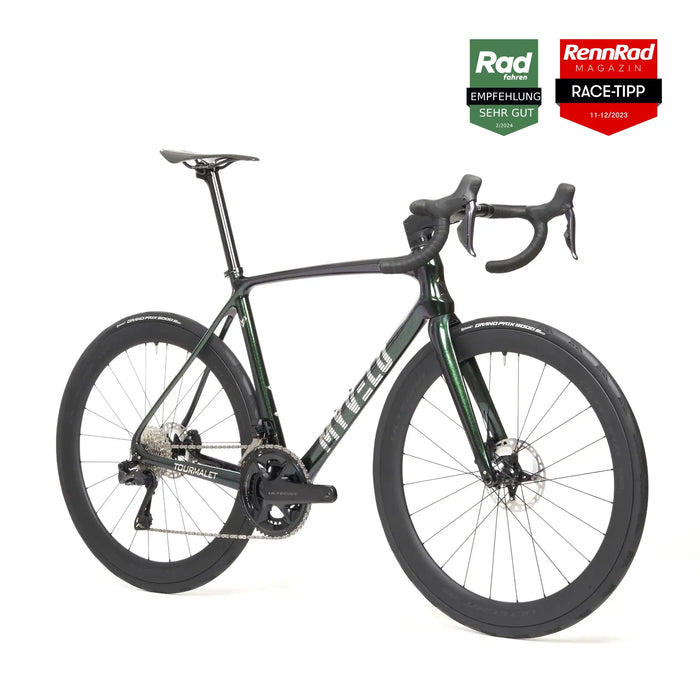
Tourmalet road bike
incl. FREE shipping & free returns

For many road cyclists, the Transalp is more than just a tour — it's an adventure, a challenge, and an unforgettable experience all in one. Anyone who has ever crossed the Alps on two wheels understands why this tour never fails to inspire.
Von Fabian Huber |
3 minutes read time

The term Transalp refers to the crossing of the Alps from north to south, or vice versa, by road bike. The route typically starts in Germany, Austria, or Switzerland and ends on the Mediterranean in Italy. Numerous passes with steep climbs and rapid descents are negotiated. The exact route varies depending on the plan; anything from a leisurely leisurely ride to a high-performance sporty tour is possible.
The reasons to undertake a Transalp are as varied as the Alps themselves:
Sporting challenge: Over 1,000 kilometers and several thousand meters of altitude demand fitness and stamina.
Pure nature: Breathtaking mountain landscapes, picturesque valleys and traditional Alpine villages invite you to marvel.
Community experience: Many people do the tour in groups or at organized events – a perfect opportunity to meet like-minded people.
Overcoming personal limits: A Transalp not only trains the legs, but also the mind.
Cultural discoveries: The route leads through countries with rich histories, whose culture can be experienced through monuments and traditional customs.
A special place along some Transalp routes is the Patani Memorial at the Stelvio Pass. The memorial commemorates the young Italian professional cyclist Fabio Patani, who had a crash there in 1985. For many riders, the memorial symbolizes not only a memorial, but also motivation and respect for the sporting achievements of past generations.
As you ride past, you can feel the power of this place – it reminds you to consciously and respectfully test your own limits. The Patani Monument is more than just a stone in the mountains: It connects racing bike history with the challenge of crossing the Alps.

The so-called "King's Stage" is the sporting highlight of every Transalp. It leads over one of the highest and most famous Alpine passes, often the Stilfser Joch (2,757 meters), sometimes also the Timmelsjoch or the Großglockner.
Why is it called the Queen Stage?
Extremely demanding: With up to 40 kilometers of ascent, some with double-digit gradients, it tests your physical and mental resilience.
Breathtaking view: Once you reach the top, a panorama awaits you that makes you forget all your efforts.
A sense of triumph: anyone who completes this stage has mastered one of the greatest challenges in Alpine cycling.
For many riders, this stage is the emotional and athletic highlight of the entire Transalp tour. It demonstrates what road cycling in the high mountains truly means: pain, willpower, and, in the end, pure joy.
A successful Transalp requires more than just endurance. Here are a few holistic tips:
Mental strength: Visualize the Tour, especially the queen stage. Mental training helps when your legs get tired.
Regeneration: After each stage, targeted stretching exercises, massage and good sleep are essential to regenerate the muscles.
Nutrition: Carbohydrates for energy, proteins for muscle building and electrolytes for mineral balance.
Technique: In addition to fitness, safe riding technique is crucial on the alpine descents over serpentines.
Equipment: A lightweight, well-maintained road bike with well-matched gearing and weatherproof clothing are essential. You should also bring an emergency kit with a spare tube, pump, and multi-tool.

The Transalp is not only a sporting challenge, but also a journey through a landscape full of contrasts. The mighty peaks, lush meadows, crystal-clear mountain lakes, and quaint villages create a complete experience for all the senses. After the physical exertion, nature rewards you with peace and space – perfect moments for mindfulness and inner balance.
The Transalp is a holistic adventure that challenges and nurtures body, mind, and soul. Whether gazing at the Patani Monument, conquering the Queen Stage, or enjoying the Alpine panoramas – this tour is an experience that will linger long after your arrival. For any road cyclist who wants to experience the fascination of the Alps in an authentic way, the Transalp is an absolute must-do.

Wer regelmäßig mit dem Rennrad unterwegs ist, kennt das Ritual: Nach einer langen Ausfahrt oder vor einem knackigen Intervalltraining führt kein Weg am Espresso vorbei. Ob in der italienischen Bar an der Strecke, auf dem Marktplatz nach dem Sonntagstraining oder zuhause aus der Siebträgermaschine – der Espresso ist fester Bestandteil der Rennradkultur. Doch was steckt hinter dieser Verbindung aus Koffein, Stil und Leistung?

Wer an Rennradfahren denkt, hat oft Bilder von durchtrainierten Beinen, kraftvollen Antritten und aerodynamischer Haltung im Kopf. Doch ein Muskel spielt eine unterschätzte, aber entscheidende Rolle: der Beckenboden. Er ist nicht nur für Stabilität und Körperkontrolle wichtig, sondern auch für Komfort, Leistungsfähigkeit – und die langfristige Gesundheit auf dem Rad.

Die Auswahl an Fahrrädern war noch nie so groß wie heute. Rennrad, Mountainbike oder doch ein Gravel Bike? Jedes dieser Bikes hat seinen eigenen Charakter, seine Stärken und idealen Einsatzbereiche. Doch wo liegen die Unterschiede – und welches Rad passt am besten zu Dir und Deinem Fahrstil? In diesem Artikel erfährst Du, was die drei Bike-Typen auszeichnet, welche Vor- und Nachteile sie haben und worauf Du bei der Entscheidung achten solltest.